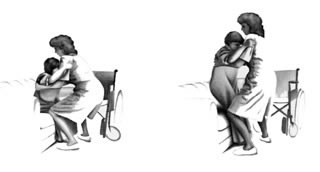Safe Lifting for Caregivers
Author: Irma Beberashvili,
Safe Lifting for Caregivers
Proper lifting techniques are essential to prevent caregiver injuries. According to the Occupational Safety & Health Administration (OSHA), lower back injuries are the most common work-related injury. Many caregivers experience back injuries while lifting or moving clients.
Safe lifting protects both the caregiver's back and the client from injury. Specific lifting techniques minimize lower back strain.
Safe Lifting Basics
- Assess the situation carefully. Determine if you can handle the lift or transfer alone, or if assistance is needed.
- Inform the client of your plan and how they can assist.
- Clear any potential obstacles.
- Moving or supporting someone affects your balance. Keep the client close to your body’s center of gravity. Avoid reaching too far.
- Position your feet shoulder-width apart, with one foot slightly ahead of the other. Point one foot in the direction of movement.
- Bend your knees. Bending at the waist strains back, neck, and shoulder muscles.
- Keep your arms and elbows close to your body.
- Use your feet to change direction; walk or pivot the client without twisting.
- Lower by bending your knees, maintaining a straight back.
- When lifting with others, communicate clearly so everyone knows their role.
Helping Someone Sit Up in Bed
- If the client cannot push up, place one arm under their legs and the other under their back.
- Pivot the client’s body, moving their legs over the bed's edge, until they are seated.
- Maintain a shoulder-width stance, bent knees, and a straight back.
Helping Someone Stand Up
- If the client uses a wheelchair, position it close to the bed or chair and lock the wheels.
- To assist the client, face them, position your feet shoulder-width apart, and bend your knees.
- Position the client’s feet on the floor and slightly apart. Their hands should be on the bed or your shoulders.
- Place your arms around the client’s back and clasp your hands together, or use a lifting belt fastened around their waist. Grasp the belt when lifting.
- Hold the client close, lean back slightly, and shift your weight.
Helping Someone Sit Down
- Pivot towards the chair, bend your knees, and gently lower the client.
- Ensure the client places both hands on the chair arms before lowering.
Client and caregiver safety are paramount during mobility assistance. Planning the move and using proper lifting techniques minimizes injury risk.
Contact Us:
For a certified home health aide for yourself or a family member, please call:
+1 551 247-1454.



